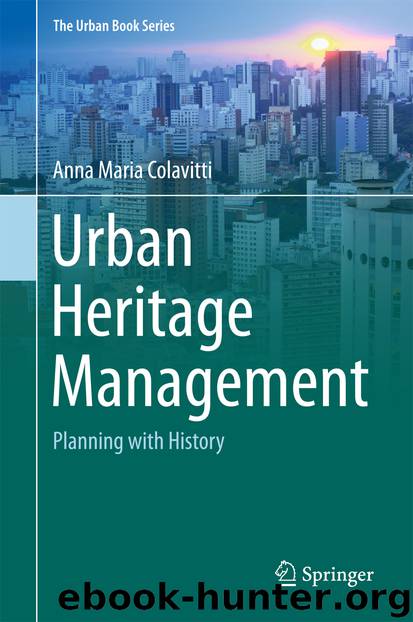Urban Heritage Management by Anna Maria Colavitti

Author:Anna Maria Colavitti
Language: eng
Format: epub
Publisher: Springer International Publishing, Cham
3.2.5 The Metropolitan Areas
The expansion of the city in relation to the emerging of the industrial civilization, the big concentration of population around the productive centers and the concentration of all the directive central roles in few urban centers, configures itself as a new big conurbation formed by the spatial and functional welding of originally distinct centers. The city emerges for its fundamental attracting role, but it becomes also the core of a new spatial system of which the population mobility represents a distinctive element and reduces the chances of cultural and material production that are, precisely, the raison d’être of the modern metropolitan areas.
Generally speaking, we can distinguish at least three different conceptual definitions of the metropolitan area. The first one sees it as an urbanized continuum of large dimensions; the second one identifies the metropolitan area as a complex and integrated system of several interrelated centers, of which, at least one, has a position of superiority; a third one defines an urban reality in which important functions and roles for the whole nation or just part of it, are concentrated together and must be kept within a specific proximity (AA.VV. 1991). These definitions are complementary and not alternative and strive for a continuous intertwining of meanings and functions. On a territorial level, the metropolitan areas tend to form an even wider structure: the so-called megalopolis, that consists of several metropolitan areas linearly arrayed along wide traffic directories linking one another. Complementary to the big metropolitan organisms is the formation, in the surrounding or intermediate areas, of less dense urban structures having the most varied and differentiated functions, although equalized in terms of dimension and importance (Lugli 1967).
Anyway, such areas tend to saturate the present environment, with the expansion of an uninterrupted built area, characterized by a principle of non quality, that gradually but surely transforms the perception of the space over time. The phenomenon of expansion of the city and the relationship between city and territory represent one of the most crucial emerging issues of the modernity.
Download
This site does not store any files on its server. We only index and link to content provided by other sites. Please contact the content providers to delete copyright contents if any and email us, we'll remove relevant links or contents immediately.
| Africa | Americas |
| Arctic & Antarctica | Asia |
| Australia & Oceania | Europe |
| Middle East | Russia |
| United States | World |
| Ancient Civilizations | Military |
| Historical Study & Educational Resources |
Underground: A Human History of the Worlds Beneath Our Feet by Will Hunt(12052)
Sapiens by Yuval Noah Harari(5322)
Navigation and Map Reading by K Andrew(5133)
The Sympathizer by Viet Thanh Nguyen(4338)
Barron's AP Biology by Goldberg M.S. Deborah T(4122)
5 Steps to a 5 AP U.S. History, 2010-2011 Edition (5 Steps to a 5 on the Advanced Placement Examinations Series) by Armstrong Stephen(3707)
Three Women by Lisa Taddeo(3391)
Water by Ian Miller(3155)
The Comedians: Drunks, Thieves, Scoundrels, and the History of American Comedy by Nesteroff Kliph(3056)
Drugs Unlimited by Mike Power(2564)
A Short History of Drunkenness by Forsyth Mark(2258)
DarkMarket by Misha Glenny(2194)
The House of Government by Slezkine Yuri(2178)
And the Band Played On by Randy Shilts(2165)
The Library Book by Susan Orlean(2051)
Revived (Cat Patrick) by Cat Patrick(1974)
The Woman Who Smashed Codes by Jason Fagone(1945)
Birth by Tina Cassidy(1884)
The Absolutely True Diary of a Part-Time Indian by Sherman Alexie(1881)
